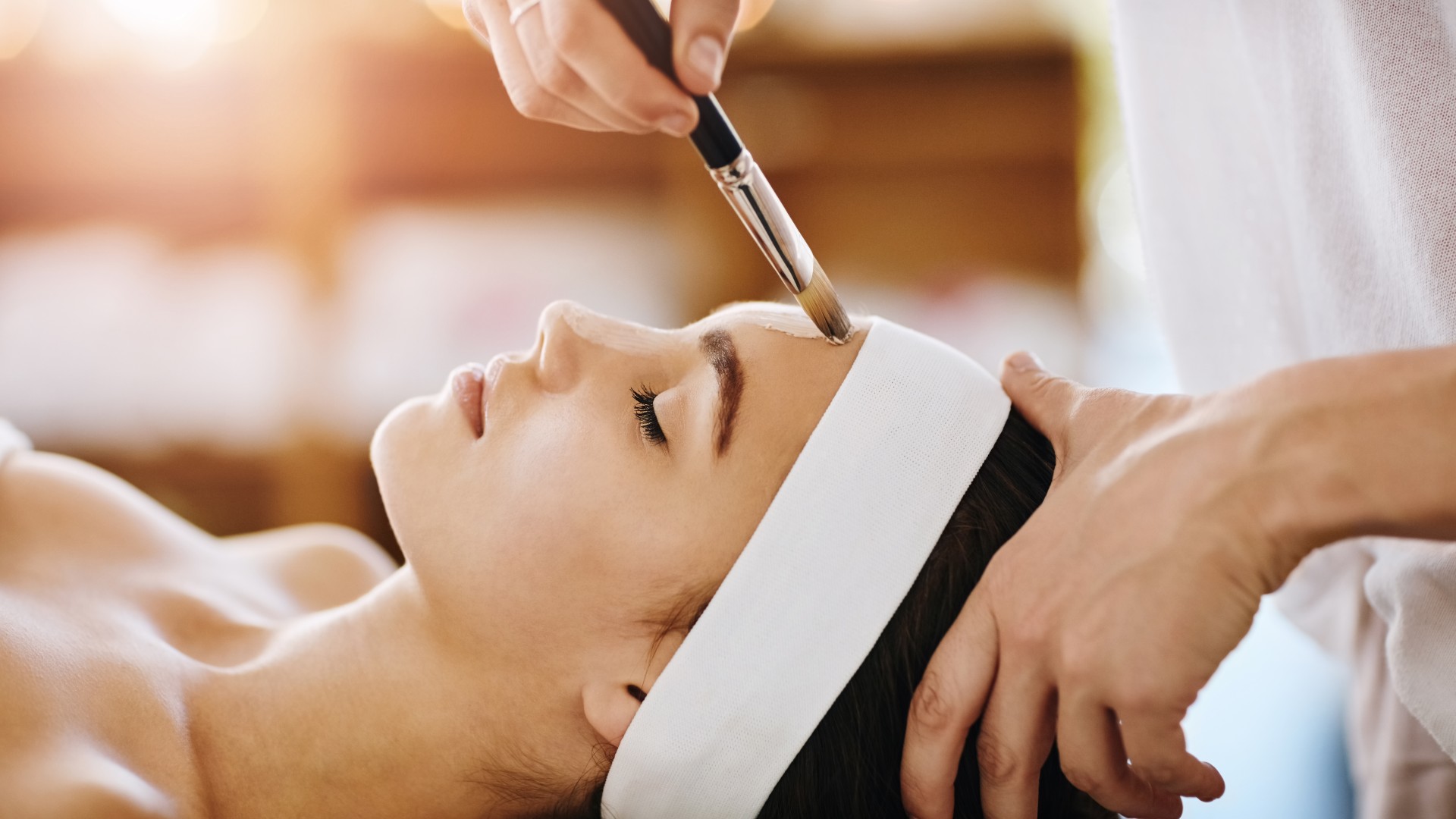Chemical Peels for Acne Scars: An Expert Explains
It's complicated.


I could go on and on and on about the multitude of benefits that come with both in-office and at-home chemical peels. There’s the exfoliation factor, the skin brightening effect, the hyperpigmentation correction—and that’s just the start. Chemical peels have also long been a treatment for acne scars, which are defined as “an indentation or textural change related to the trauma of an acne lesion and has been present for at least a year,” says board-certified dermatologist at Entieré Dermatology Dr. Robert Finney. Unfortunately, chemical peels for acne scars aren't a cut-and-dry treatment. Don’t get me wrong: They can work wonders for scar prevention, and certain types of professional-grade peels can improve texture and tone, but it’s important to recognize that a little salicylic, glycolic, or lactic acid isn’t the be-all-end-all for acne scarring.
“Because there’s such great technology these days, most dermatologists are using lasers or devices to treat acne scars rather than these deep chemical peels, like phenol peels,” explains board-certified dermatologist and founder of Niche Dermatology Dr. Shari Marchbein. Some doctors might suggest intense peels to speed along resurfacing (it depends on a range of factors, including the type of scar you have), while others might steer clear of ‘em all together in favor of microneedling or laser resurfacing.
Your treatment should be personalized and your dermatologist is going to be your guide. But a little on-your-own research never hurts. That in mind, we’re explaining the benefits—and limitations—of chemical peels for acne scars, ahead. (To see which products can help treat acne before it scars, read up on the best acne spot treatments, the best skincare routine for acne, and tips for treating hormonal acne.)
Should I Get a Chemical Peel to Get Rid of Acne Scars?
It’s complicated—we know, not the answer you were looking for. “Theoretically, any chemical exfoliation is going to stimulate collagen. Of course, the deeper the peel goes, the more collagen it will stimulate,” explains Dr. Marchbein. So, while a light chemical peel or an at-home peel pad might even out skin texture and give you a brighter, more exfoliated complexion that’s ever-so-slightly less textured, it’s going to do next to nothing for true acne scarring. “I use chemical peels more for melasma, post-inflammatory hyperpigmentation, and active acne, whereas we save our fractionated laser and microneedling radio frequency for the more serious collagen production and scar improvement,” says Dr. Finney.
Medium or deep resurfacing chemical peels historically have been used to treat more intense scarring. While they do work and are recommended for certain types of scars, they’re not always the best bet when laser treatments for acne scars and microneedling are viable options. Because not only do chemical peels typically require a full face injury, but the results likely will not be as impressive as those provided by high-tech, targeted treatment devices. “You’re going to create a full thickness wound and have a risk of pigmentation and further scarring,” explains Dr. Finney. “The depth at which you can penetrate with a chemical peel is going to be a lot more superficial than, say, fractional technology.”
Types of Chemical Peels
There are a handful of peels on the market, ranging from very low intensity at-home peel pads to very high intensity in-office peels that require a lot of downtime. Picking the best option for you will depend on A) where you are in your acne journey, B) the depth of scar you’re trying to treat, and C) alternatives available to you.
“You have to pick the chemical peel based on the depth of the scars that you need to treat,” says Dr. Marchbein. “But, because of the great technology these days, most dermatologists will use lasers or devices to help treat scarring rather than peels.”
Stay In The Know
Get exclusive access to fashion and beauty trends, hot-off-the-press celebrity news, and more.
At-Home Peels
Go to Sephora, Ulta, or even browse on Amazon and you’ll find a ton of at-home chemical peel solutions and pads. While at-home peels are not really going to do anything for atrophic acne scarring, they can help prevent acne scars, even out small changes in texture, and treat very mild scarring. Reason being, they’re a lot less powerful than professional treatments. “It’s a fractional response,” says Dr. Finney. “Most of the peel pads are going to be five percent glycolic acid or two percent salicylic acid.” In-office? You can be looking at something along the lines of 70 percent glycolic acid.
Still, that doesn’t mean at-home peels aren’t worthwhile. In fact, Dr. Marchbein recommends that her patients, namely those dealing with active acne, do an at-home peel once per week. It can treat hyperpigmentation and mild scarring, while salicylic acid variation can “go into the oil glands and unclog pores.” (Doctor’s note: Skip acne medication and retinol when doing an at-home peel.)
Light Peels
These types of in-office chemical peels are going to require little to no downtime and are typically used to help treat active acne, prevent scarring, and help with minor textural and color changes. “It can help unclog the pores and treat active acne,” says Dr. Finney. “You’ll also be building a little bit of collagen to prevent scarring and treat the pigment that’s left behind from acne marks.” In a professional setting, you’ll probably receive trichloroacetic acid, glycolic acid, or a Jessner peel, which is a combination of glycolic acid, lactic acid, and an acne-fighting ingredient called resorcinol. “Treatments are typically done every two to four weeks until we see improvement,” he adds.
Medium and Intense Peels
If you want a peel that’s actually going to improve the look and texture of acne scars, you’ll need to discuss this category with your dermatologist. As previously mentioned, TCA (trichloroacetic acid) Cross is one type of peel to consider–especially if you’re dealing with ice pick scarring, aka small, narrow indents in the skin. “We use TCA for a lot of things, including the treatment of warts, among other things. It works by breaking down proteins and then it obviously builds collagen,” explains Dr. Marchbein. This needs to be administered by a skilled professional and, in the treatment of ice pick scars, is a very precise and targeted application.
Another popular peel in this category is something called a phenol peel, which is able to penetrate deep into the skin. “These are much deeper chemical peels and you need to monitor the heart while you’re doing it,” says Dr. Marchbein. “But they can be used to full resurfacing.”
Is There a Risk Associated With Chemical Peels for Acne Scars?
The biggest risks you have to contend with are hyperpigmentation and, unfortunately, additional scarring. “It all depends on the peeling agent,” says Dr. Finney. “The stronger you get and the deeper you go, you’re going to have a much higher risk. Lighter peels, like glycolic peels, your risk is extremely low. But as you get into more intense ones, like phenol peels, the risk and the downtime goes significantly up."
How Long Will It Take to Recover From a Chemical Peel?
The deeper and more intense your peel is, the longer your recovery period will be. Something like a TCA Cross peel might have a 10 day recovery, whereas a super light glycolic acid peel won’t have any downtime at all.
How to Take Care of Skin After a Chemical Peel
Aftercare instructions will differ depending on your specific treatment, and, depending on your peel, you might be instructed to wash your face with only water for the first two days of recovery. You’re also going to be best prioritizing all gentle products. “Until the skin no longer feels sensitive, it’s likely just going to be a gentle cleanser, a moisturizer that’s thicker and cream-based, and sunscreen,” says Dr. Finney. “You also want to be off of your active acne ingredients and retinols.”
Do I Qualify for a Chemical Peel to Treat Acne Scars?
While chemical peels might be a mainstay in treating active acne, they're only going to be useful in treating very, very specific types of acne scarring, as there are so many amazing alternatives (read: microneedling and laser treatments). The two main deciding factors? The type of scarring you have and your skin tone.
Type of Scarring
First and foremost, let’s acknowledge that post-inflammatory hyperpigmentation, aka the dark marks left behind by pimples, is temporary and therefore not a scar. That said, light chemical peels (think: glycolic, lactic, or Jessners) can be *highly* effective at treating hyperpigmentation. “Lower-level peels are a really nice option for hyperpigmentation and just evening out texture, says Dr. Marchbein. When it comes to true, atrophic scars, however, these light peels aren’t going to cut it.
Intense peels, specifically something called TCA Cross, can be helpful at treating ice pick scars, which are “very narrow” indentations in the skin. “It’s a very fine technique where we take a very well-controlled amount of a highly concentrated TCA and dab it onto the scar,” she adds. “We do not want it to spread or drip.”
That said, someone with rolling scars, which are defined by undulating textural changes, or boxcar scars, which are shallow with defined edges, are likely best addressed with other treatment options.
Skin Tone
If you have darker skin and acne scarring, a peel probably isn’t going to be your best bet. Because you’ll be at a higher risk of hyperpigmentation and scarring, your chemical peel will be more superficial. And unfortunately, the more superficial a peel, the less significant the results. “For a Fitzpatrick skin type six, you have to go very light and only use certain ingredients. Even then, there’s a risk of hyperpigmentation,” says Dr. Finney. “You’re not going to be able to actually attack your scarring.”
Meet the Dermatologists

Originally from Pittsburgh, PA, Dr. Finney completed his undergraduate and medical degrees at Pennsylvania State University. He completed his internship and dermatology residency at Thomas Jefferson University Hospital in Philadelphia, PA where he served as chief resident during his final year. He also performed a postdoctoral research fellowship in eczema and allergic contact dermatitis at Rockefeller University in addition to an advanced fellowship in aesthetics, hair restoration, and skin surgery with renowned hair surgeon Dr. Marc Avram in New York. Dr. Finney is a clinical assistant professor at New York University Langone and teaches future dermatologists at Bellevue Hospital.
Dr. Finney is an expert in medical, surgical, and cosmetic dermatology and is regularly asked to contribute to various media outlets, including Men’s Health, Men’s Journal, Esquire, and Women’s Health. He does not approach aesthetics from a cookie-cutter approach, rather he works closely with each patient to design a customized treatment regimen to achieve his or her desired aesthetic outcomes that appear natural and refreshed, never over-done.

Dr. Shari Marchbein is a board-certified dermatologist and a fellow of the American Academy of Dermatology. Dr. Marchbein’s academic and clinical interests include the treatment of acne, in particular adult female acne, acne scarring, and rosacea. She also specializes in various aesthetic procedures and laser surgery. Dr. Marchbein has been sought out as a leader in her field for the treatment of acne and rosacea and has published multiple articles on acne pathogenesis and treatment. She has presented at renowned national conferences on the topics of acne and rosacea, including the annual American Academy of Dermatology and Advances in Dermatology meetings. Dr. Marchbein earned her Bachelor of Science degree from the State University of New York at Binghamton where she graduated Summa Cum Laude and became a member of the Golden Key National Honor Society and Phi Beta Kappa National Honor Society.

Samantha Holender is the Senior Beauty Editor at Marie Claire, where she reports on the best new launches, dives into the science behind skincare, and shares the breakdown on the latest and greatest trends in the beauty space. She's studied up on every ingredient you'll find on INCI list and is constantly in search of the world's glowiest makeup products. She's constantly tracking the biggest nail and hair trends to pop up in the beauty space, going backstage during fashion weeks, tracking celebrity looks, and constantly talking to celebrity hair stylists, nail artists, and makeup artists. Prior to joining the team, she worked as Us Weekly’s Beauty and Style Editor, where she stayed on the pulse of pop culture and broke down celebrity beauty routines, hair transformations, and red carpet looks. Her words have also appeared on Popsugar, Makeup.com, Skincare.com, Delish.com, and Philadelphia Wedding. Samantha also serves as a board member for the American Society of Magazine Editors (ASME). She first joined the organization in 2018, when she worked as an editorial intern at Food Network Magazine and Pioneer Woman Magazine. Samantha has a degree in Journalism and Mass Communications from The George Washington University’s School of Media and Public Affairs. While at GWU, she was a founding member of the school’s HerCampus chapter and served as its President for four years. When she’s not deep in the beauty closet or swatching eyeshadows, you can find her obsessing over Real Housewives and all things Bravo. Keep up with her on Instagram @samholender.
-
 Princess Anne's Unexpected Suggestion About Mike Tindall's Nose
Princess Anne's Unexpected Suggestion About Mike Tindall's Nose"Princess Anne asked me if I'd have the surgery."
By Amy Mackelden Published
-
 Queen Elizabeth's "Disapproving" Royal Wedding Comment
Queen Elizabeth's "Disapproving" Royal Wedding CommentShe reportedly had lots of nice things to say, too.
By Amy Mackelden Published
-
 Palace Employees "Tried" to Get King Charles to "Slow Down"
Palace Employees "Tried" to Get King Charles to "Slow Down""Now he wants to do more and more and more. That's the problem."
By Amy Mackelden Published